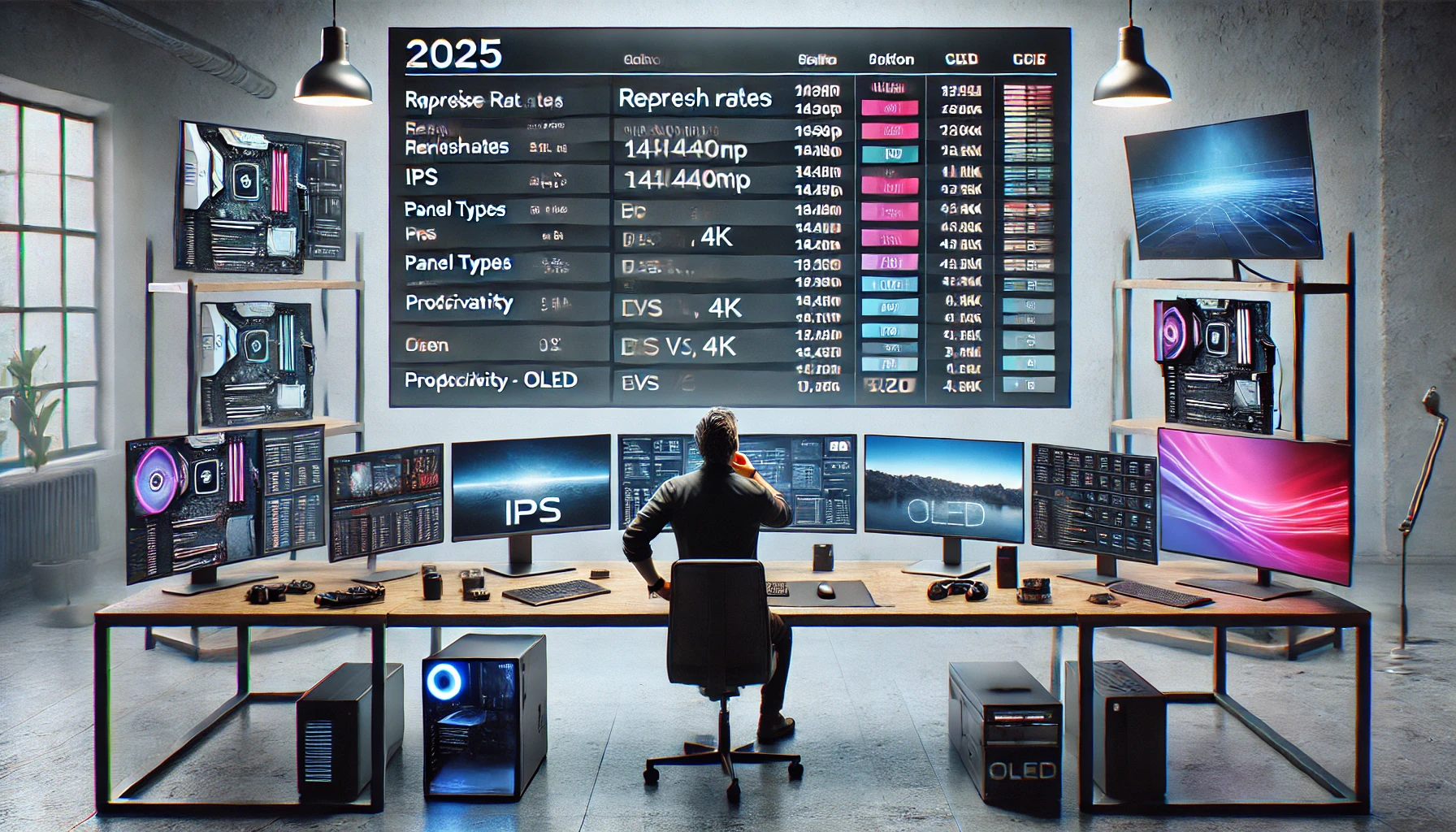Whether you’re building a gaming rig, a productivity workstation, or a general-use PC, the monitor is the component you’ll interact with the most. A good display enhances everything—from gameplay and design work to everyday browsing. In 2025, monitor technology has advanced significantly, offering higher refresh rates, better color accuracy, and more resolutions than ever before.
In this guide, you’ll learn exactly what to look for when choosing a monitor for your PC, based on your needs, budget, and setup style.
1. Define Your Main Use Case
The “best” monitor depends heavily on how you use your PC. Start by defining your main purpose:
| Use Case | Monitor Priorities |
|---|---|
| Gaming | High refresh rate, low response time, adaptive sync |
| Video editing | High color accuracy, 4K+ resolution |
| Office/Productivity | Ultra-wide or dual monitors, comfort, low blue light |
| Streaming & Media | Good contrast, HDR support, large screen |
| General use | Balanced features, Full HD or higher |
💡 Start with your primary task—then look for features that enhance that experience.
2. Choose the Right Screen Size
Monitor size is measured diagonally, in inches. Here are some guidelines:
- 24″ – Great for small desks, general tasks, or competitive gaming
- 27″ – Most popular size in 2025; ideal for work and play
- 32″+ – Great for immersive experiences, multitasking, or media consumption
- 34″-49″ Ultrawide – Ideal for video editing, productivity, and immersive gaming
💡 Bigger isn’t always better. Choose a size that fits your desk and viewing distance (ideally 60–80 cm away).
3. Understand Screen Resolution
Resolution impacts sharpness and how much content fits on the screen.
| Resolution | Pixels | Best For |
|---|---|---|
| 1920×1080 (Full HD) | Basic use and budget builds | |
| 2560×1440 (QHD/2K) | Gaming and productivity | |
| 3840×2160 (4K UHD) | Video editing, high-end content creation | |
| 5120×1440+ (Ultrawide) | Multitasking, immersive workspaces |
💡 QHD (1440p) is the sweet spot in 2025 for gaming and daily use.
4. Refresh Rate: For Gamers, It Matters
Refresh rate is how many times the image refreshes per second (measured in Hz).
- 60Hz – Standard for non-gamers and office use
- 75Hz–100Hz – Smoother desktop experience, light gaming
- 144Hz–165Hz – Popular for competitive gamers
- 240Hz–360Hz – High-end gaming monitors for esports
💡 Combine high refresh rate with low input lag and fast response times (1ms) for the best experience.
5. Panel Types: IPS vs VA vs OLED
Panel technology affects color reproduction, viewing angles, and contrast.
IPS (In-Plane Switching)
- Accurate colors and wide viewing angles
- Ideal for creative work and general use
- Slightly lower contrast than VA
VA (Vertical Alignment)
- Better contrast and deep blacks
- Good for watching movies and casual gaming
- Narrower viewing angles than IPS
OLED / QD-OLED
- Superior color, contrast, and true blacks
- Ultra-fast response time
- More expensive, potential for burn-in
💡 For most users, IPS panels offer the best balance between color, speed, and price.
6. Adaptive Sync Technology
To reduce screen tearing and stuttering in games, look for:
- G-SYNC (NVIDIA GPUs)
- FreeSync (AMD GPUs)
Many modern monitors are G-SYNC Compatible, meaning they work with both GPU brands.
💡 Adaptive sync is essential for a smoother gaming experience, especially at 100Hz+.
7. Color Accuracy and Bit Depth
For photographers, designers, and editors, color accuracy is key.
- Look for monitors with sRGB 99%+, AdobeRGB, or DCI-P3 coverage
- A 10-bit panel (8-bit + FRC or native 10-bit) supports more color shades
- Consider factory-calibrated monitors or use a colorimeter for precise calibration
💡 Color grading? Prioritize HDR10+, DisplayHDR 600+, and wide color gamut.
8. Curved vs Flat Screens
Curved monitors can enhance immersion and reduce eye movement—especially ultrawide displays.
- 1000R or 1800R curvature mimics natural vision
- Useful for gaming and ultrawide multitasking
- Flat monitors remain ideal for precise work like photo editing
💡 Curved is best for 32″ and larger displays. Under 27″, the effect is minimal.
9. Connectivity Options
Make sure the monitor supports the ports you need:
- HDMI 2.1 – For high refresh rate and consoles (up to 4K 120Hz)
- DisplayPort 1.4 / 2.0 – Preferred for high refresh rates and resolutions on PC
- USB-C / Thunderbolt – Great for laptops, single cable setups, and data
- Audio out / built-in speakers – Optional, but convenient
💡 Using a GPU? Use DisplayPort for best performance.
10. Ergonomics and Eye Care
- Height, tilt, swivel, and pivot adjustment = better ergonomics
- VESA mount support = use with monitor arms or wall mounts
- Flicker-free and low blue light modes = reduce eye strain
- Anti-glare coating = essential for bright rooms
💡 Comfort matters—especially if you spend hours in front of your screen.
Final Thoughts
Choosing the right monitor in 2025 is all about matching features to your needs. Whether you’re gaming at 240Hz, editing 4K footage, or multitasking across multiple apps, there’s a perfect display out there for you.
Prioritize refresh rate for gaming, resolution and color for creative work, and comfort for productivity. Don’t overspend on features you won’t use—but invest where it matters most for your setup.
